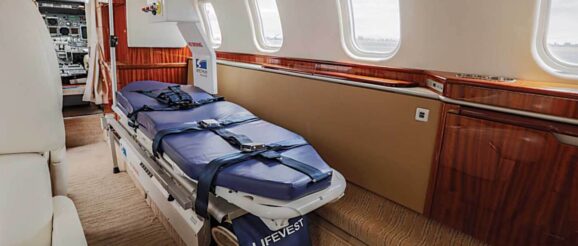Spectrum Aeromed: Customer-driven innovation

Estimated reading time 8 minutes, 8 seconds. Modern air medical equipment is getting smaller and more efficient just as selected aircraft platforms are getting bigger. This translates into more space on board for medical teams to transport increasingly complicated cases over longer distances. It’s a trend closely followed by Spectrum Aeromed, a Fargo, North Dakota-headquartered provider of modular and custom-built air medical equipment solutions for helicopters and fixed-wing aircraft since 1991. Matthew Christenson, the company’s vice president and account executive, said there is a definite global trend toward using longer range fixed-wing aircraft for medical transports. “It’s driven by the opportunity to bring people home or bring them to a specific hospital or facility where they need specialized treatment,” he said. With longer flights comes the need for more equipment. “Having oxygen available along with additional monitoring devices is crucial,” Christenson said. “With advancements in technology, especially in medical devices, they are getting smaller in size which allows for their integration within medical flights. Over a short period of time, the opportunity air medical teams have to provide amazing medical care is changing rapidly. New innovations emerge every few months.” Thomas Redder is Spectrum Aeromed’s vice president of international sales. Based in Germany, Redder confirmed the trend toward longer range medical transports. “Formerly it was quite acceptable to take a Learjet 35 from Australia to Europe with multiple fuel stops, but that is becoming less acceptable,” Redder observed. “We are now looking at aircraft that fly non-stop from the Middle East to the U.S.” In addition, some customers are dedicating an aircraft purely to air ambulance missions in order to maximize space and comfort for the patient. “We’re creating new stretchers and new devices. It becomes more like a hospital,” Redder said. “We have developed new types of oxygen storage because more is needed. The charging of medical devices becomes more important as we see a trend toward more complicated medical cases like heart or lung issues.” At the moment, Redder said the most popular aircraft for conversion is the Learjet 75, with some being equipped to handle up to three patients, including heart-lung transports and incubators for small babies. Every completion is customized to some degree, he said. Even within Europe, air ambulance systems need to be customized for different gas and oxygen outlets. “Then we have all the different kinds of medical devices. There are different brands of ventilators, monitors and defibrillators.” Streamlined solutions Spectrum Aeromed is focused on growing with its customers, aligning its air medical innovations with customer needs. “We really allow the customers to lead us,” Christenson said. “Our emphasis is on getting the right setup, but we let the customer determine what is right for them. What is their scope, their plan, what kind of patients are they transporting?” Recently, Spectrum Aeromed introduced a brand-new air medical system, the Infinity 5000X. Lighter and fully self-contained, the 5000X was designed in collaboration with flight nurses and air medical teams and provides unobstructed access for patient care and transfer. “It’s an all-inclusive system with oxygen, air pumps, a vacuum pump and inverter power in the base system that attaches to the floor,” Christenson said. “On top of that is the patient stretcher or incubator transport system for infants.” He said the 5000X is lighter than other standard applications, so medical teams can bring on more gear. “We can accommodate more medical devices when we’re looking at that equipment integration. One possible layout allowed for up to 70 pounds [32 kilograms] of added medical devices,” Christenson said. Another innovation is Spectrum Aeromed’s adoption of liquid oxygen (LOx), which has now been incorporated into five of its supplemental type certificate applications, including the Bell 429, AW109/119, Bell 407, King Air 350 and Pilatus PC-12 aircraft. “Liquid oxygen is a big space saver,” Christenson explained. “You can take on longer missions with a 10,000-liter [2,640-US gallon] orb, the size of a basketball. A standard module compressed tank has only 3,500 liters [925 US gallons] and is eight inches by 40 inches tall.” While LOx is common in military applications, it is only now starting to bridge the gap to civilian air medical transports. As it becomes more readily available, “we just need customer education,” Christenson said. “Helicopter and fixed-wing clients are showing interest for longer range flights for patients who need high oxygen volume.” Finally, as the air medical equipment field continues to develop rapidly, Spectrum Aeromed is focused on delivering streamlined solutions, taking on even more aspects of an interior completion. “It’s what we’re calling a turnkey application for a customer,” Christenson said. “We are now handling more of the project than just the medical devices. It might be a dedicated sidewall, or coordinating the paint and avionics upgrades. We can handle more of the interior completion and remove some of those pain points for the customer. We understand what needs to be done. Again, it’s about growing with our customers and responding to their needs.”
